NDA Triumph – A Look Back
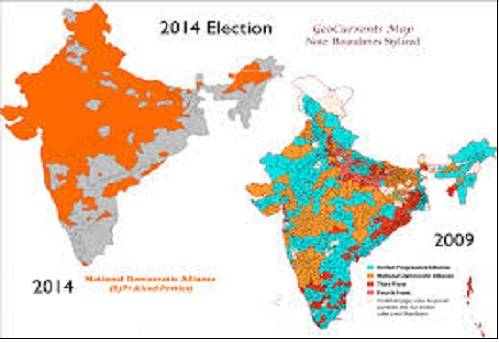
2014 – MY BIG FAT INDIAN ELECTION: A RETROSPECIVE
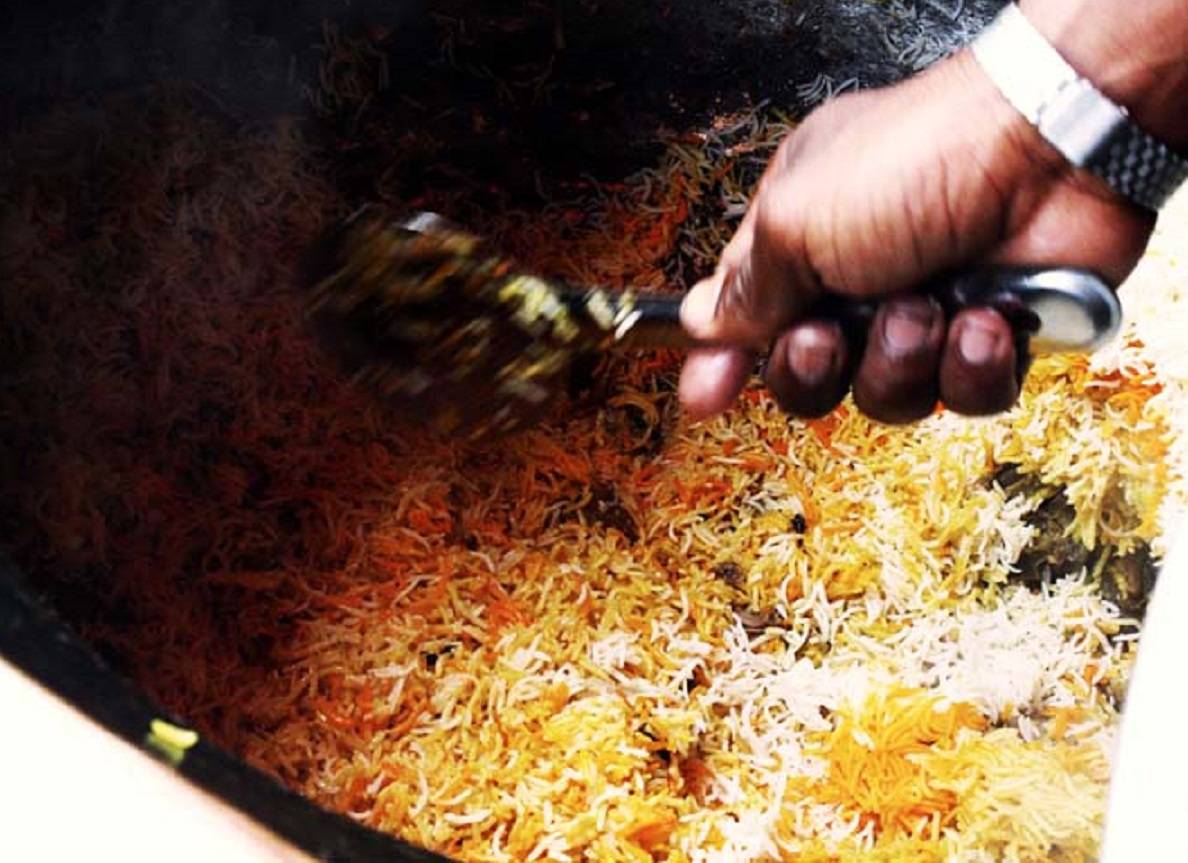
Biryani Served at the Jami Majid, Delhi
Stomachs full of fermenting slogans and cheap booze, pockets somewhat sparse with spent wrinkled rupees pulled out by the owner, sometimes by the cohort, I thought I would venture to stir the serfs still suffering from conscious dissonance, and ask them for their opinions about what was undoubtedly the Biggest Fattest Indian Election in History
During The furor of electioneering, it was hard to get people to talk. They parroted slogans in fear of reprisals from the boss men the apparatchik, who monitor the discipline of the election machine just as a foreman would check the workings of the men who command the factory floor at night. But, a night or two after the final vote, the truth comes outh. The men are ghosts of elections past: cheap hooch mixing with decaying teeth, eyes of the red with a crackly blur of blazed hashish leaving holes where organs of sight must have been whole, one a young day as children looking out into their village fields, today it is all because of the money weighing down the right folds of their pockets, the average Indian election worker seemed esoterically proud do describe his role in the largest exercise of democratic animation in history.
But with so much to cover, we must relegate the subjectof their accounts to a shore up an ending to a sandwhich of facts of the intemperate towering kind, to wrap the mind around a vote that outmaneuvers all decisions in human history..
BIG VOTES – BIGGGER MONEY
Just in terms of the numbers, this has been the most expensive election in the history of the country. While the actual counting is in the process of bring sanctified, it seem that at a price tag of nearly a $five billion per vote, second only to the 2012 election of the United States of America: one beholds images that of hypocrisy Himalayan heights as cumulous clouds dance Bollywood numbers blowing smoke rings of dollars above a landscape that was a disaster zone just twelve short months ago.
However, to understand the paradox, one must appreciate the Indians’ collective psychology, post-1990s reforms. “We are no longer a poor destitute undignified country” says Kuldip Mathur, a tea stall merchant (the same profession as his idol) the Prime-Minister designate if the polls are correct, Narendra Modi who made a decent wage selling tea before becoming an activist and later politician, for the man is a specimen of the ‘Twice Born – not a Brahmin from the aristocratic priest caste who controlled the flow of education in in ancient India but those being born after independence and brandishing the confidence of the 1990s new liberalizetion defined a country no longer feeling guilty of acquiring material goods. They are the new twice born; and they are not shy of showing the privilege they bear.
So far, the macro-economics works. Staples are still much lower than that of the West as are rice and pulses. Mathur like many from his community are vegetarians an can save or invest their earnings by foregoing meet consumption. Cell phones and data plans are dirt cheap; and getting around on an autorikshwaws costs aroundn two pence. A sense of community is crucial: the local clubs hold functions to help young boys in Mathur’s impending matrimonial position. Sathpathy, his tea swilling boss, now munching on an eggroll, concurs.
To a great extent, he is right. The “green revolution has made scarcity a phenomenon of our parents’ generation. Canadian Norman Borlaug, the “Father of the Green Revolution” credited with saving over a billion people from starvation, involved the development of high-yielding varieties of cereal grains, expansion of irrigation infrastructure, modernization of management technique of which our farmers would be proud
But where should all well fed these people live?
Mumbai has broken the top 15 places most valuable places in which to live in the world, so dreams of Bollywood are out of the question, The answer is not all that complicated: the figures citing 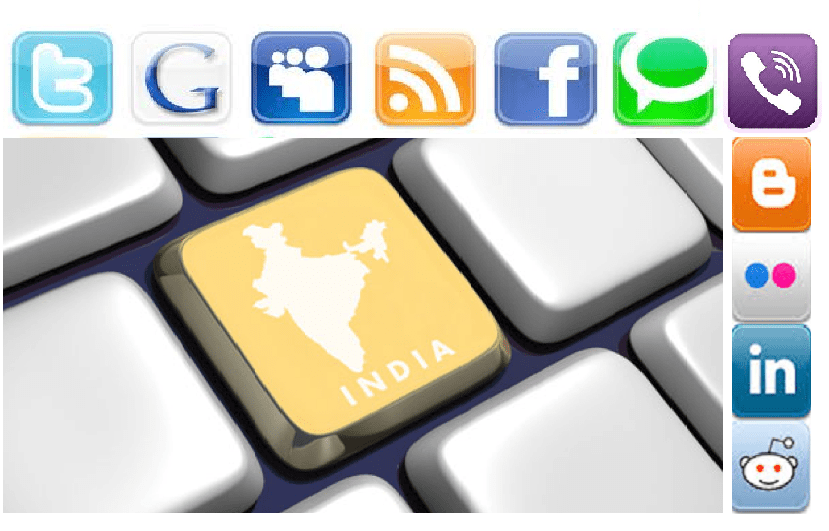 Mumbai in luxury markets are for the top tier of residential properties. Most poor people live outside of such metropolitan centers in places known as Bustees (not slums); these are government reserved shanti towns in which long-time tenants have rights to pay the government over 99 year leases at a pittance for their dwellings. These makeshift habitations are often located in prime `real estate zones, and developers are paying top dollar to get rid of these nuisance paupers, offering up their rights for high fees, so they can go elsewhere and live in the country. But the pauper’s aren’t so stupid. The more nuisance they create, the greater will be the fee extracted from developers, and they demand jobs as caretakers, security men. Yes…India, is indeed becoming a land of negotiated advantage.
Mumbai in luxury markets are for the top tier of residential properties. Most poor people live outside of such metropolitan centers in places known as Bustees (not slums); these are government reserved shanti towns in which long-time tenants have rights to pay the government over 99 year leases at a pittance for their dwellings. These makeshift habitations are often located in prime `real estate zones, and developers are paying top dollar to get rid of these nuisance paupers, offering up their rights for high fees, so they can go elsewhere and live in the country. But the pauper’s aren’t so stupid. The more nuisance they create, the greater will be the fee extracted from developers, and they demand jobs as caretakers, security men. Yes…India, is indeed becoming a land of negotiated advantage.
Money in their pockets, these once loud bellowing barkers of the markets now save their vocal chords for thwo,three, sometimes four SIM IDs, many containing caller tunes,which they hum to their theme songs as they use the devices to to run businesses, check the prices of goods in out of state markets, how much the middlemen are charging, at what rate is money changing?, etc. can they find a transportation route around them?
Others live in scaffolding, some containing carcinogenic asbestos (sold in India by Canada and other countries) as they learn the construction trade of India’s ever ballooning real estate bubble. Getting Canada to talk about the asbestos trade is harder than getting electioneering manipulators to talk about buying votes.
Then comes the Ghoosh economy: Black and ‘grey’ markets in which goods sold are either as stolen and refurbished, or sold tax free. the ‘grey ‘ pilfered samples and prototypes are of particular of interest because of their legitimacy in not being called stolen. Wares have a sheen of respectability about then Even technology publications quote the ‘grey’ market prices for phones, regularly as if these should be legitimately purchased items. But grey markets are illegal. These are test products brought in by manufacturers to assess the viability of their main product in a large market. But they’re being gobbled up by grey market dealers who do not pay tax and make a hefty on the difference between the Maximum Retail Price of a bonafide good and the cheaper but decent quality copy made by an engineer (most likely from China or South Korea where they have become experts at reverse engineering) they’ve managed to negotiate from the poor seller, who parts with his good, job in peril, for a pittance, to feed a low-cost pseudoblack market.\. In a price sensitive market where Indian’s get few benefits from the taxes they pay, it is seen as almost to buy full price , payin full VAT.
What about the Monsoon Wedding, surely thre is something pure bout the charm of life imitating art? Well there bribes and their families pay open Ghooses’ to police, and public officials in general to quash first marriages, second affairs, etcl, and absolve grooms from criminal records, so the fabled unions can take place. The rains wash away all such sins, and the pairs lives begin anew.
Still more perilous is the hiding of money: Have an income tax problem – just pay a “criminal lawyer” as Jesse Pinkman might say in the popular complete series “Breaking Bad” and the income tax official will pocket a decent share of the unpaid taxes as will the lawyer. Need a nice stretch of land for development: the local politician will ‘organize’ a collective price from the sellers that is conducive to your budget – oh…that doesn’t mean he won’t come back for more, later.
A friend named Pankaj tells me his story: “I was the worst student in the class. Many times my mother had to plead with the headmaster not to expel me. By the same token, my friend Samrat was a very diligent chap. He didn’t score the top marks but he passed within the first division. Samrat got Central government job, and he now has job security, a flat, a motor bike, and buys the best fish in the market but he works like a dog a the beck and call of his master. Me – I have had nothing – but the party has given me everything” (by this he means the All India Trinaool Party) one of the regional parties contesting elections in West Bengal. “When I got married, they raised money for my ceremony. When I needed a flat, they found me one.Today, I am an MLA in a rural constituency. All construction projects must bear my tacit approval – and this means that I get definite benefit. I don’t know how long Trinamool will last. These things are cyclical. But after 33 years of CPI (M) Communist rule in Wet Bengal, the rank and file, those who run the machinery of the political party defected to Trinamool, giving them the advantage. The same could happen some five ten years down the line, and then I will wear another colour.”
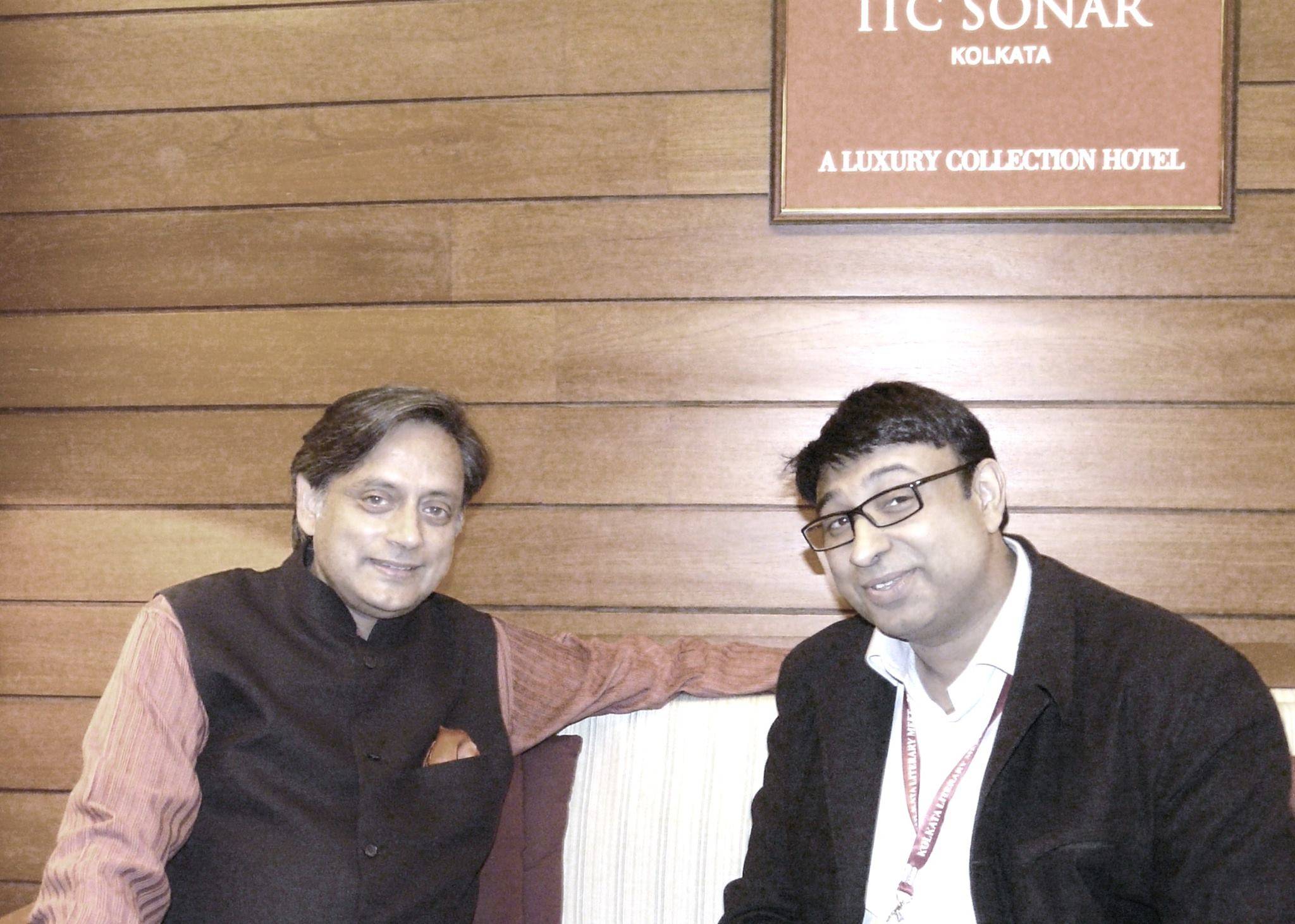
Pankaj’s Idol, MP and Celebrity Shashi Tharoor
(Pankaj’s picture cannot naturally be shown)
“The only people who study hard in West Bengal want to get out. They want work in It HUBS LIKE Bangalore, Financial Centres like Mumbai, top medial facilities like All India Institutes of Medical Sciences in Delh – or they want to make their to the West. But even these days, the people are saying life is too hard in the west – it’s much easier to do ‘Adda’ lay about and gossip while your domestics do all the housework. My ambitions are different. I will eat, now, keep a wife in my constituency and high class mistress in the city, and maybe one day a man will put a bullet in my head. I don’t care. MY son know’s where my gold is buried.”
In Pankaj, we see an embodiment of the old politics, demonstrating the might of the party machine, showing all that might it ritght. But new polities has entered the digitial age in a land where the information worker has outstripped that of their agrarian brothers:
NARENDRA MODI’S QUIET DIGITAL CAMPAIGN
During the run-up to the 2011 state elections in Calcutta, Delhi and Mumai, the uniform cacophonic layer of howling busses, beeping horns, and running voices, permeating the air was regularly pierced by the boom of loudspeakers, sometimes fixed to lamp posts, sometimes to the top of vehicles, four, three and two wheelers alike. The ostensible purpose of these rude interruptions, blaring across the landscape, was for political announcement, to campaign for a candidate, extoll the virtues of a party leader, more often to decry the failings of opponents; to many, the real intent was demonstrate the might of the party machine to the lowly citizen.
Today, the party machine has become electronic: the streets are relatively quiet as a new type of campaign, one in which elections to come, will be won or lost in tweets, likes, and hits as bits of data are flung to and from servers, which copy, amplify and disperse them en masse to the public. This is electioneering in the information age – a flurry of quiet canvassing done through clicks and taps on electronic devices. It is evidence of a newer republic emerging from the still young country of India, born on the stroke of midnight on August 15, 1947.
Midnight’s children, those born at the moment India became independent, whose powers and failings Salman Rushdie so magically narrated in his Booker Prize winning novel of the same name, have aged; their voices have grown hoarse; their bodies have become frail; and their powers are weakening. It is their children, ‘morning’s babes’ we could call them, done with their crying and carefree upbringing, are speaking at last, asserting themselves, articulating the issues that frame the way forward for their families, their offspring. The politicians, even the old guard, pre-midnight, those born before independence, are listening – and learning.
One recent Sunday morning, The Washington Post reported on volunteers from the Bharatiya Janata Party (BJP), which is the main opposition party, fanning out across middle-class neighborhoods in the nation’s capital, making their way through, one apartment building at a time. Knocking on doors and guided by the most sophisticated set of analytical voter data that India has ever seen, they represent the new generation of party worker, educated, urban, and subtle.
When a sleepy young man at one door said he favored the party’s candidate for prime minister, Narendra Modi, the volunteers pounced.
“Are you on Facebook? Twitter? Do you use WhatsApp to chat with friends? We would like to send out some political jokes, Modi messages and videos. Can you post and circulate them among your friends?” asked Mahavir Mittal, 45, an English speaking business owner, one of a new breed of election volunteers deployed on the streets.
On Monday, millions headed to the ballot box in the first phase of the largest election in history, which could oust the party that has dominated India’s politics for decades and see the voters move beyond what it has casted as traditional priorities such as caste and religion, to focus on government corruption and the economy, two serious touchstones for the incumbents.
India’s electorate is starkly different today compared to voters a decade ago, when Congress Party Prime Ministerial Candidate, Manmohan Singh first headed a coalition government, the United Progressive Alliance, which has ruled India since. About two-thirds of the population is younger than 35. Voters are more urban and vastly more connected than ever before. Upwardly mobile urban dwellers make up about one-third of the electorate. And these young movers and shakers, headphones on, eyes on their handhelds, have no patience for old-style politics.
To reach them, political parties are going beyond the traditional campaign rallies, packed with supporters bussed in by candidates. Now, they are pursuing U.S.-style campaign strategies, including volunteer mobilization, social media outreach and micro-targeting of various groups — such as business executives, students and retirees living in secure communities. The parties hope to engage members of India’s growing middle class who, in previous elections, stayed home instead of waiting in long, chaotic lines at polling stations.
It is the BJP, who are the most attuned to this strategy. In 2004, voter apathy is what was attributed to the surprising defeat of a popular incumbent BJP-led coalition government. With a polarizing septuagenarian Prime Ministerial candidate fielded in 2009, they fared no better.
“They couldn’t mobilize their base.” Says Sumeet Kumar, a retired political scientist, observing the election in India in 2014. “They don’t want to repeat this mistake, especially when the Congress government is riddled by scandal, and there is such an anti-incumbent feeling.”
The tactics are also targeting India’s youth, which, if taken as a block would surely swing the election. The number of first-time voters has increased from 43 million in 2009 to 101 million, out of 814 million eligible voters, according to the Election Commission of India.
In the past, voters often cast ballots along caste, religious or ethnic lines, sometimes following a village elder’s orders. This benefited the governing Congress party, which has a large presence in the countryside.
“I am impatient. Some days I feel that our old-style politics and politicians will never change, but then there are days when I feel there is still some hope for India,” said Tavleen Kohli, 22, a graduate student of psychology in Gurgaon, a suburb of the capital. “Jobs are important for me, but so is clean politics. In this election, many of my friends feel that our vote matters.”
Siddhant Gupta, 19, a communications major at ILEAD College, Calcutta, agrees. “I’m the least political person around but even I get lots of messages via Whatsapp on politics, and it really draws you in. There are a lot of people my age who’ve become politically engaged because of this”
It is for this reason, perhaps, and the strong anti-incumbancy/anticorruption feeling that permeates thhhe thought of those who contemplate another five years of the failed UPA government that has caused Modi’s Bharatya Janata Party to do so well in the polls – far better than analysts earlier expected.

BUT WHO IS NARANDRA MODI ANYWAY?
To the west he is the bogeyman who did little if anything to prevent the massacre of around 1200 pople, 80 percent of them Muslims, and had referred to an Islamic refugee camp as a “baby-making factory”. It Caccording to Manushi, a widely respected liberal magazine in India, In the 2012 Gujarat Assembly elections, 31% of Gujarati Muslims voted for the Modi-led BJP despite media and NGOs launching a high voltage campaign against Modi for being a “divisive” force in Indian politics. The enormous increase in Muslim vote for BJP was dismissed by Modi-Haters, including reputed political scientists not neary as many Muslims had voted for Modi out of fear, the fact is that Muslims are a savvy eperinced group fo voters who have had nearly 70 years to vote, and not all Mulims see it this way “we need (to) sic at. The BJP will give us a least guaranteed meal. UPA has promise us since the days of Indira Gandhi to remove poverty, and improve the lives of Muslims but at the state level, they are even worse than the BJP towards Muslisms. These ‘secular’ Hindus; such men are all are propagators of nepotism, and their sons and daughters retain power rather than to allow others to enter political space. Modi transformed the state of Gujrat into an economic powerhouse while the rest of India has lagged behind under these so called ‘secularists’. He has no children, so there is no room fo nepotism. No Modi will succeed him. He has said that he will be for all Indians, including Muslims, and we should give him a chance to lift us out of poverty when after sixty years of Congress rule, they have failed miserably,” says Khalid Bhatti, a factory worker.
Still, one man’s view is not definitive. One hast to ask if the epiteths ring true? Two decades ago, these were the same accusations being levied at L.K. Advani, who since then got into trouble during a trip to Pakistan in which he extolled the virtues of Mohammed Ali Jinnah, father of that state.
This is something that irks veteran journalist Mark Tully who, born in Calcutta, has deep roots in India spanning more than fourtyyears. “As long as they can make the debate about secularism vs. Hindudtva, the Congress can scare voters into place. But that’s not happening.”
Modi is accused of failing to stop the massacre of some twelve to fifteen hundred people, around eighty percent of them Muslims during a retaliatory riot for the killings (burning alive of 58 Hindu pilgrims on a train). I asked Mr. Tully during an exclusive interview earlier this yeaer whether such revenge killings were unusual in the context of state politics, and whether the scale actually makes Modi rise to the level of devil. He remarked that Congress did the same thing when Sikhs were massacred en masse after Indira Gandhi was assassinated in 1984. Mentioning that by her grandson an undeclared Prime Minisiserial candidate Rahul Gandhi was stopped by the government yet the Godhra carnage was permitted to continue caused Mr. Tully’s to be outraged “That is utter nonsense! They stopped the killings against Sikhs after maximum carnage was achieved, and the fact that they were able to do so very quickly – let’s remember they had the army at their disposal whereas Modi did not – demonstrates that they could have stopped the genocide – and yes, that’s what it was in against
Sikhs, much earlier. In fact, arguably, what Congress did in 1984 was worse than what Modi failed to do in 2002. In sheer numbers, around 10,000 Sikhs were killed to one thousand Muslims in Godhra, a difference of ten fold. Does that mean that one muslim is worth the lives of 10 Sikhs as far as electoral politics is concerned? “Yes, says the World Sikh Organization” who is trying to keep the orchestrators of the massacre like Kapil Sibal out of the United States just as similar campaigns were organized for Modi.
Tully continues: “Moreover, it is wrong for any group to murder innocent civilians, whether they are Sikh shopkeepers or Hindu Sevaks – why should a population stand idle when the press reports that nearly 60 religious workers were burnt alive in what would likely have been one of the most cruel and painful ways to die! Would this not cause a riot in other countries?”
In fairness to Modi, he had just come to power, and was still leveraging his hold over the civic machine. Others accuse him of calling up Muslim leaders and taunting them before ordering their bodies to be hacked to death. There has been no evidence of the latter, and Modi was absolved in an inquiry on the matter. But he remains the bogeyman
THE OLD POLITICS ARE BACK IN THE CITIES
In the final two days before election loudspeakers were mandated to be silenced by the law, we did hear the loudspeaker campaigns in our neighbourhoods. We heard Trinamool, instead of going after their main rivals Congress (I) and the CPI (M), they went after Modi for by they, they had realized that Narandra Modi, who made no less than three visits to the state, which his party had written off during the last campaign, was going after the non-Bengali Hindus, who had embraced the saffron flag, and also after Urdu-speaking Muslims, who had been taken for granted by the minority pandering left parties of west Bengal. At the very least, his strategy of coming in hard and splitting the opposition, caused panic among the local Netas or leaders. Mamata Banerjee talked about her record of grassroots campaigning, about sharing the wealth, and about protecting agrarian classes from industrialization. The CP(I)M talked about Mamata’s failings; that business was leaving in droves, unemployment at an all time high, prices skyrocketing amidts an economic policy to which former FICCI Chairman Amit Mitra had become handcuffed. And, The Congress talked of the dynasty. First there was Babar, then Humayun, then Akbark, the Great, then, Jahangir and Arungzeb – the continuity of leadership – this was the Congress party’s last desperate selling point. And it fell on deaf ears.
While the vote will not be officially ratified until May 31, to paraphrase a former Prime Minister of India who awoke to life and freedom, he said of India that we achieved , “ freedom, not in whole measure but very substantially. It is rare in history when we step out from the old to the new, when an age ends, and when the soul of a long suffering nation funds utterance.?
Today, the new Prime Minister Designate said, confidently where his the first Prime Minister’s speech had hailed victory without a hint of it mired in defeat or regret as Nehru had, as the following: “The results show that people – all people, have voted with hope and optimism. There is new hope among people that this dispensation can fulfill their aspirations, and we will endeavor to do this, proudly, and in the name of Mother India.
For Analysis, please click on the following link:
 The Global Calcuttan Magazine
The Global Calcuttan Magazine 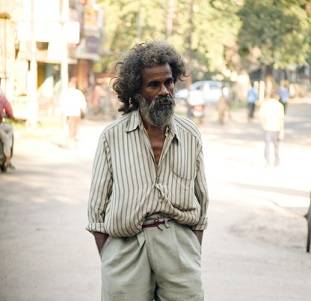
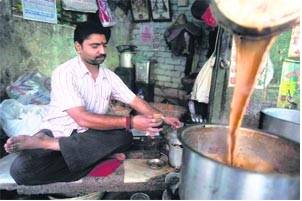
Great analysis of the election, post-mortem. I just hope Modi builds on what he has achieved so far!